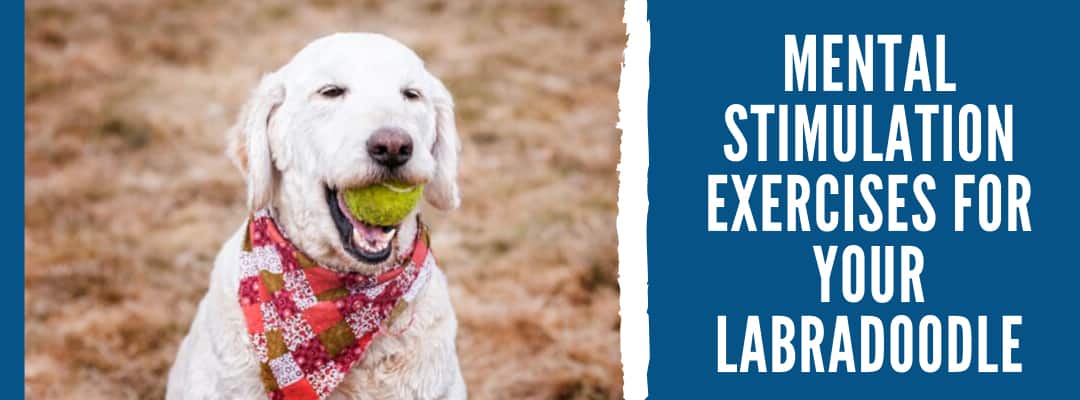Ask a Labradoodle owner if their dog is intelligent, and you’ll almost certainly get the same answer each time: this breed is super smart. That hyper-intelligence can either be something you brag to your friends about as your fluffy friend performs another fantastic feat, or it can be something that you moan into your hands when you discover that Fluffy has, once again, escaped her crate, pushed a stool over to the counter, and snarfed down your freshly baked muffins.
Mental stimulation and exercise is important for all dogs, but it is hugely important for breeds, like Labradoodles, that display higher-than-average levels of intelligence. This guide will show you how to harness that intellectual superpower and redirect it toward positive avenues. Labradoodles will thrive when their minds are stimulated just as frequently as their bodies, and owners can keep their Doodle’s brains sharp with scent games, puzzles, agility exercises, searching activities, and much more.
By actively exercising a Labradoodle’s brain, you will relieve him of excess energy, help him learn new problem-solving strategies, and develop a close and personal bond as you tackle new challenges together.
A Word About Intelligence In Labradoodles
The Labradoodle is, without question, one of the most intelligent dog breeds. This is likely due to the influence of their parents’ genes. A first-generation Labradoodle has genetic building blocks from a Poodle and a Labrador Retriever. The Poodle is widely believed to be at the top of the canine intelligence hierarchy, second only to the Border Collie. Poodles are quick-witted and clever, and they can learn a huge assortment of commands and perform complex tasks.
Labrador Retrievers may not have the rep for intelligence that Poodles do, but don’t let their dopey, everything-is-awesome personality traits fool you. Labradors were bred as hunting companions, and they are very acutely attuned to their owners’ moods and needs at all times. This combination of razor-sharp Poodle intelligence and emotionally-savvy Labrador intelligence has resulted in the Labradoodle: a happy, eager-to-please dog breed with more than a few crafty tricks up its sleeve.
It can be difficult for some owners to identify intelligence in their Labradoodles. After all, a curly-coated beast who would tumble through a screen door or knock a guest over while trying to leap into his arms doesn’t immediately suggest a high level of intelligence. But exuberance and clumsiness should not be mistaken for stupidity. In fact, the opposite is often true. Many dogs with high levels of energy and low apparent control over their impulses are actually exhibiting characteristics of a highly intelligent dog suffering from insufficient stimulation.
What Are The Benefits of Mental Stimulation?
An insufficiently stimulated Labradoodle can be quite the problem. Dogs suffering from a lack of mental exercise can develop issues like anxiety, hyperactivity, stress behaviors such as chewing, digging, or licking, attachment issues, separation problems, lethargy, and much more. As people, we recognize the signs of low stimulation in our own minds: we get listless and depressed, we can’t find the energy to complete basic tasks, and everything starts to glaze over and seem terribly monotonous.
Of course, a dog’s intelligence isn’t on par with our own, but a dog is prone to these same effects. Your Labradoodle is a product of thousands of years of genetic variation and development. Her canine brain is still very similar to the brains of her wild ancestors, and to this day wolves use their brains for a variety of activities, including:
- Hunting for food
- Avoiding danger
- Evaluating new situations and environments
- Socializing with other canines in their pack or other packs
- Solving problems on the go
- Navigating through territory
A canine’s brain is so powerful that it can successfully navigate several life-or-death situations on a daily basis. Imagine possessing a brain capable of all this yet being confined to a living situation where you have no opportunities to flex those powerful mental muscles!
What Your Labradoodle Gets Out Of It
So, what changes can you expect to see in your Labradoodle when you incorporate brain games into his schedule? First and foremost, you are going to see a happier animal overall. Happy dogs have bright, attentive eyes. They watch closely and take in new information constantly. They are curious, and that sense of curiosity is rewarded. Happy, intellectually stimulated Labradoodles possess all of the traits that made you fall in love with the breed in the first place.
A few of the benefits Labradoodles can receive from regular mental stimulation and exercise include:
- Improved problem-solving skills
- Better understanding of the intricacies of human communication
- Activated reward centers in their brains
- Release of pent-up energy
- Reduction of issues with sleeping or eating
- Learned social skills
- Stronger connection to their owners
What You Get Out Of It
The benefits of mental agility training are not for your Labradoodle alone. You’ll get a lot of benefits, too, when you schedule continual mental stimulation and brain games with your furry friend. Here are just a few of the human perks to owning a Doodle with a healthy, active brain:
- Reduced destructive behavior like digging or chewing
- No excessive energy, which might lead to jumping or barking
- More predictable sleep schedule
- Fewer occurrences of separation anxiety
- No embarrassing anti-social outbursts around other people or dogs
- Easier communication with your Labradoodle
- Hours of fun playing and training
- Strengthened bond between you and your dog
As you can see, mental stimulation and exercise improve the relationship between human and dog from both sides. Not only will your Labradoodle be more at ease when his mind is being exercised, but you’ll receive a myriad of benefits as well. The best part? All of these benefits can be achieved without expensive training sessions, high tech toys, or hours of patient practice. All it takes is a few simple games each day to change the mental health profile of your Labradoodle.
Next, we’ll discuss a few games, appropriate for indoors and outdoors, and explain how you can use them to boost your Doodle’s brainpower. Let’s look at some easy indoor games first.
Stimulating Indoor Games
Rainy days don’t have to stop you from stimulating your Labradoodle’s mind. There are plenty of simple, short games you can play on a regular basis to keep your pup’s thinking skills razor-sharp. Here are a few suggestions for indoor games:
Find The Treats
This is a simple game that challenges your Labradoodle’s smelling power. Hide a few tasty treats in a room inside your home while your dog isn’t looking, then bring him in and tell him to find the treats. You might need to lead him to the first one so he knows what he’s searching for. The process of hunting and subsequently finding something is incredibly stimulating to a dog, and you can increase the stimulating effect by lavishing your Doodle with excited praise each time he finds a treat. He’ll know that you’re happy when a treat is discovered, and this will raise the stakes of the game because your approval is infinitely better than even the tastiest treat.
The Classic Shell Game
You’ve probably seen a video or two of impressive pups playing the shell game. Here’s how it works: a treat is hidden under one of three small cups or shells. The shells are then rapidly mixed up, and the dog has to choose under which shell the treat is hiding. This game tests a Labradoodle’s nose skills, visual tracking abilities, and attention span. It’s also just a great opportunity to spend some one-on-one time with your Doodle, which further cements your bond.
Hide And Seek
Here’s a game that is guaranteed to be as much fun for you as it is for your Labradoodle. Have someone keep your dog in one room while you seek out a hiding spot somewhere else in your house. You can make the game more challenging by setting up some false clues: open a door to a room you aren’t hiding in, make noise in another part of the house, etc. Once you’re well-hidden, call to him. You’ll love witnessing your pup’s determination as he searches high and low. The real reward in this game is how excited your Labradoodle will be when he finally finds you. Nothing beats that doggy grin.
Introduce The Unexpected
Sometimes all it takes is the introduction of something new into your Labradoodle’s environment to have far-reaching effects on her mental acuity. A new addition as basic as a cardboard box presents a score of decision opportunities to your dog. What is this thing? Can I sniff it? Should I taste it? Can I get inside it? What happens if I tear it? This may not be an exact translation of your Doodle’s inner monologue, but it does illustrate that the gears in her brain are turning. Exposure to new stimuli is something you would expect an animal to encounter in the wild, so bringing a little taste of that stimulus into the home is supremely beneficial.
Clean Up Games And Named Toys
You’re probably familiar with the concept of teaching children to clean up their toys, but there’s no reason why your child-like Labradoodle can’t be given the same responsibility. To your Labradoodle, clean up is a fun game that involves finding something that’s out of place and putting it in the correct location; it’s basically a hunting game. Find a basket or container that you can use to house all of your dog’s toys and accessories, and be sure that your Doodle can easily reach in and grab what she wants.
When the toys are strewn about and your living room has reached chaos levels, you can show your Labradoodle how to pick up her toys one by one and place them back in the bin. You can even use individual names for the various toys, so instead of just saying “Pick up your toys,” you would give a more complex challenge like “Put [Toy Name] away.” Heap on the praise for each toy returned to the bin, and by the end of this game your Labradoodle will be squirming with delight.
Learn A New Trick
One of the best ways to mentally stimulate your Labradoodle is by teaching new tricks. Smart dogs can learn over 150 unique words, and dogs will rely on facial expressions, body language, and even tone to further their understanding of human communication. It’s usually a good idea to focus on learning one new trick at a time, and starting with an easy command like “sit” is advisable. When progressing to more complicated tricks, ensure that your dog doesn’t become frustrated by returning to an easy command every so often, so your buddy still gets a reward even if he’s struggling with a new concept.
Here is a list of common tricks that you can easily teach your Labradoodle. Intelligent dogs love to learn new commands, and you can use the commands to teach behaviors with real-world uses:
- Sit: Teach your dog to sit on command
- Stay: Teach your dog to sit and stay where you point, even if you walk away
- Come: Teach your dog to come when he is called, and for another layer of a challenge try teaching your dog to come even when he is occupied with something else, like a favorite toy
- Poison: Also called “Leave It,” teaches your dog to ignore a treat placed on the floor until you say it’s okay to eat. Extra challenge: teach your dog to balance a treat on her nose!
- Lie Down: Use this command to get your dog to relax from a sitting position into a fully reclined position
- Fetch: You can pair the fetch command with one of your Labradoodle’s favorite toys, so he can be taught to retrieve one of a number of different items
Notice that this list of tricks isn’t just a bunch of novelty commands used to impress your friends (even though it absolutely will impress them). Each trick can be used in daily life. Imagine, for example, that you drop something inedible on the floor and your Labradoodle starts to lunge for it. Just use the “poison” or “leave it” command and your pup, who knows what that command means and has had lots of practice, will know to leave it alone. Without this training, you’d find yourself trying to pry whatever you dropped from their mouth.
Dogs who don’t understand what their owners want can become frustrated and even frightened. A Labradoodle’s congenial temperament makes this dog breed one of the most eager to please, and if they know what’s expected of them, they will rise to the occasion. Teaching tricks to a dog is really an exercise in language development, and you and your Doodle can work together to come up with a language you both understand. Smart, right?
Stimulating Outdoor Games
When the weather’s nice and the sun is shining, you have a perfect opportunity to move those brain-stimulating activities outdoors. You’ll need a few fun and engaging games to get started.
Fetch
Fetch is a classic human/dog game, but there are ways to boost the mental stimulation factor. The repetition of throwing a ball for your Labradoodle to grab and then return can lose its effectiveness over time. Instead, you can try throwing multiple toys at once and giving your dog a command as to which one to fetch first. If that’s a little too advanced, try throwing a ball for your dog to fetch and then, as soon as his attention is diverted, hiding somewhere. When he returns with the ball he’ll discover an added task: locating his human so the ball can be thrown again.
Chase or Tag
Chasing games mimic the natural chase instinct that has developed in dogs over thousands of years. You’ll want to focus on your pup chasing you, rather than you chasing them. In the event that your dog it to ever run off, getting them to chase you can be a great way to retrieve them.
Walking Games
Going on long, leisurely walks with your Labradoodle is a great way to keep his physical fitness at healthy levels, but it’s not really high on the mental stimulation scale. Dogs may not be able to admire the scenery on a walk like we can, but they do love to explore, so consider taking a mid-walk break to allow your dog to sniff and discover. You can even head out pre-walk to hide a new toy in an inconspicuous place on your walking route. Then, when you and your Doodle are out for a stroll, you can herd him toward that spot and encourage him to find the toy. Be advised, though: once your Labradoodle finds a toy in a bush on his walk route, he will forever need to examine that bush to see if it relinquishes any more goodies.
Agility Courses
If you really want to tingle the neurons in your Labradoodle’s active mind, consider building an amateur agility course in your own backyard. In agility competitions, dogs must traverse several obstacles as fast as possible, and if you’ve ever watched one of these competitions you’ll know that the competing canines seem to absolutely love it. Obstacles might include a line of pegs in the ground that the dog must weave back and forth through, tubes and tunnels, seesaws and climbing platforms, jumping hoops, or anything that presents your dog with a new challenge.
Canine Approved Toys and Puzzles for Stimulation
As much as we’d love to spend every waking moment playing games with our Labradoodle pals, humans have other not-so-stimulating tasks that are often required of us. What do you give to an intelligent dog to keep her entertained when you can’t be there to participate? Thankfully, dog toy engineers around the world have been working on this problem for decades, and there are some amazingly beneficial toys and puzzles that can light up a Doodle’s brain like Christmas. Popular stimulating toys include:
- Treat Dispensers: toys that can be used to hide treats, which dogs must play with to release the tasty morsels
- Fetch Machines: dogs place a ball into a funnel and are rewarded by the machine launching or rolling the ball in a game of automated fetch
- Maze Feeders: intricately shaped food bowls that require dogs to use their teeth and tongues in creative ways in order to access the food
- Puzzle Feeders: dogs may be required to push levers or buttons in a specific order for treats to be released
- Snuffle Feeding Mat: a woven mat, similar to a shaggy rug, where food or treats can be hidden for your pup to find
While toys and puzzles like this will never fully replace the important mental stimulation games you play alongside your dog, they are great ways to keep an intelligent Labradoodle occupied for hours on end when you can’t be there for play time.
Related Questions
How much physical exercise does a Labradoodle need?
Mental stimulation is obviously important, but it represents only one facet of your Labradoodle’s overall health. Physical exercise is just as crucial to healthy development in canines. The American Kennel Club recommends that active breeds receive between 30 minutes and two hours of exercise each day! This doesn’t mean that you have to spend an hour hitting the pavement and an hour playing mental games each day, though. Combine mental stimulation with physical exercise to give your Labradoodle everything he needs to thrive.
What kind of dog food is good for mental development?
Your Labradoodle’s diet is a hugely important aspect of her overall health, and diet can affect mental health as well. Developing human brains need the support of a diet rich in omega-3 fatty acid chains, and one particular chain called DHA is found in abundance in the brain. Research has shown that this fatty acid actually stimulates healthy brain growth and can have dramatic results on intelligence.
This same fatty acid is just as crucial to the development of puppy brains. In the first six months, be sure that your Labradoodle is eating food that contains DHA (usually sourced from fish or fish oil), and you’ll have the smartest pup on the block.
How do I find a great training program for a Labradoodle?
Training a Labradoodle to perform basic commands like sit, stay, heel, and lie down is great for improving behavior and helping owners communicate with their canine pals. Dog training, though, can be an acquired skill, and if you are new to the training world, you might consider participating in a training program with your Doodle.
Find a training program that involves multiple dogs and owners participating at once, so your dog can develop good social skills. Ask potential trainers about their training philosophy and experience, and be sure that they focus on a positive reinforcement training method rather than a negative one. Social media review sites like Facebook or Yelp can also be a great way to find a high-quality program for you and your Labradoodle.
Be Mindful About Your Doodle’s Mind
George R. R. Martin, author of the world-famous A Song of Ice and Fire book series, once noted that “a mind needs books as a sword needs a whetstone, if it’s to keep its edge.” Of course, Labradoodles can’t read, which is all the better for them as Martin fans have been waiting for him to complete his book series for over 20 years. They do, however, need their brains sharpened just like we do. Since your pup can’t curl up with a stimulating book, he is going to rely on you to provide the mental stimulation that his active brain requires.
Mental games and exercises will help curb some of your dog’s more destructive tendencies, which means she’ll dig fewer holes in the garden. It’s useful for getting rid of excess energy, which is perfect for tiring her out before you head to work. More importantly, stimulating exercises are a team effort between you and your Labradoodle, so every moment spent challenging her to stretch her brain is also a moment spent solidifying the timeless bond between human and dog.





